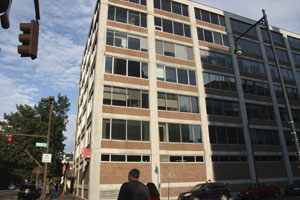
400 Main Street (1892-1960s)
In Cambridge by the 1940s, candy companies were eventually consolidated into two: Daggett Chocolates and New England Confectionary Company, or NECCO. While NECCO has survived and continues to make a large line of products, fewer people remember Daggett’s.
Fred L. Daggett opened business in 1892 in Boston and maintained multiple factories around the city. In 1925, desiring to concentrate production and distribution and to secure more manufacturing area, F.L. Daggett built his Cambridge plant, a trend popular with other confectioners seeking more centralized space.
Daggett Chocolates became a huge company producing more than 40 brands of chocolates. It took up an entire city block in Kendall Square, where it not only produced candy, but also the boxes the candy came in. The factory had three separate unions: one for the confectionery workers, one for the box makers, and one for the printers.
The company also had a special fruit department. The Daggetts owned and operated a strawberry plant in Virginia where strawberries were preserved in sugar to make fillings for their chocolates. Through this venture, the Daggetts also had an impact on ice cream and soda fountain business in the area. They supplied thousands of gallons of syrups and crushed fruits to druggists and ice cream manufacturers. In this way, candy and ice cream kind of became connected. In later years, Boston was the first place to see candy actually being mixed in to ice cream, but that’s something I’ll talk about later in the tour.
In the late 1950s, Fred L. Daggett, the founder, died. The company survived for a few years, but closed in the early 1960s. The equipment and the recipes were sold to NECCO and the building was sold to MIT. Though it was a loss to the city, I think Daggett may have avoided an even more embarrassing fate. Their end came at the start of a tumultuous time for the chocolate industry. A good example is Schrafft’s in Charelstown. Its building, with the giant clock tower and red sign visible from I-93 is now an office complex. The name Schrafft’s became synonymous with boxed chocolates. But by the 1950s, boxed chocolates were being squeezed off the shelves by candy bars, and in scrambling to retain market share, boxed chocolate companies were conglomerating. Schrafft’s also failed to keep up with distribution practices. The rest of the market began selling directly to chain stores, and they continued to use distributors. The company went into major dept and closed in the mid 80s after years of struggle.

